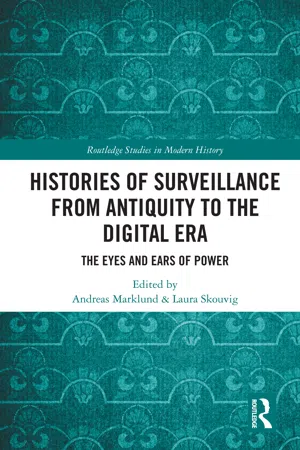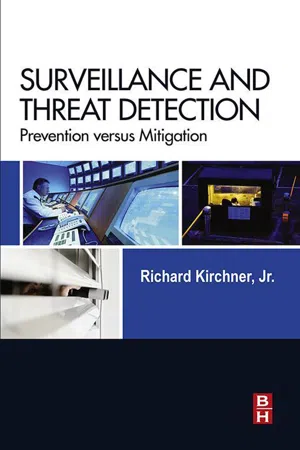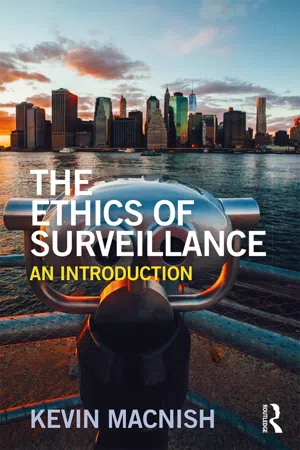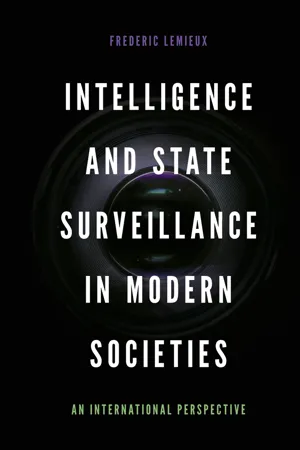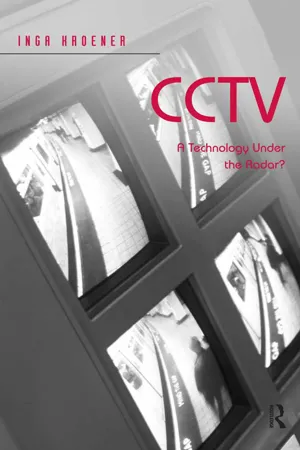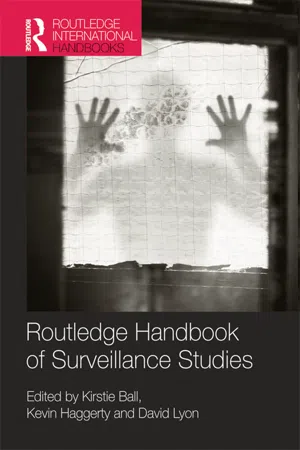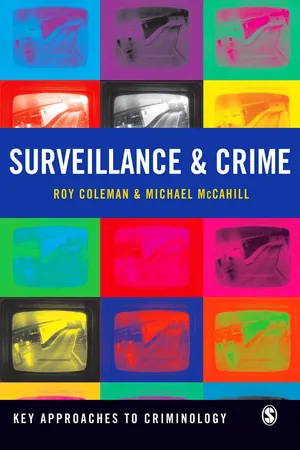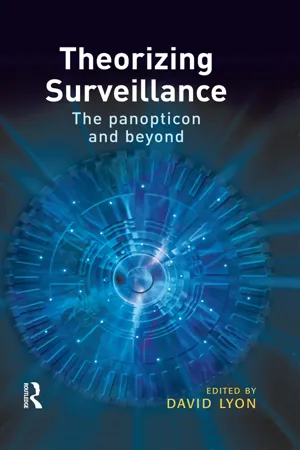History
Surveillance Technologies
Surveillance technologies refer to the tools and methods used to monitor and gather information about individuals or groups. Throughout history, these technologies have evolved from simple observation to sophisticated electronic systems, such as closed-circuit television (CCTV), drones, and facial recognition software. The use of surveillance technologies has raised ethical and privacy concerns, prompting ongoing debates about their regulation and impact on society.
Written by Perlego with AI-assistance
Related key terms
Related key terms
1 of 4
Related key terms
1 of 3
12 Key excerpts on "Surveillance Technologies"
- eBook - ePub
Histories of Surveillance from Antiquity to the Digital Era
The Eyes and Ears of Power
- Andreas Marklund, Laura Skouvig(Authors)
- 2021(Publication Date)
- Routledge(Publisher)
9 The historical ubiquity of surveillance 1 Toni Weller As a category of historical enquiry, surveillance holds a rather unique position. It is, at the same time, both a profoundly ancient social phenomenon and also a profoundly modern one. Some scholars have argued that “spying and surveillance are at least as old as civilization itself” or that “in the surveillance of private communication almost everything is history”. 2 Indeed, the idea of surveillance is so fundamentally entrenched within human history that some have explored it in terms of the “eye of God” or as God being the “original surveillance camera”. 3 And yet, surveillance also forms an intrinsically fundamental part of our modern society, impacting upon our politics, legislation, economics, culture, and personal lives, interwoven throughout our modern society. There are no teleological progressions at work here, but there are links that can be made between past and present; moreover this chapter argues that surveillance is historically ubiquitous. Taking the long view allows us to situate the idea of surveillance in the past and, in so doing, better contextualise our modern relationship with surveillance. Even more so, in relaxing the concept of surveillance from the modern, one can see that surveillance is historically present not just in technology or statecraft, but also in society and culture. In this chapter, “culture” is understood in more aesthetic terms of a reading of cultural products rather than the more anthropological understanding of scholars such as David Lyon. 4 By choosing to use this more aesthetic distinction of culture, one can argue for a more anthropological understanding of the social drivers of surveillance which follow in this chapter - eBook - ePub
Surveillance and Threat Detection
Prevention versus Mitigation
- Richard Kirchner(Author)
- 2013(Publication Date)
- Butterworth-Heinemann(Publisher)
2Overview and Understanding
Abstract
In history, surveillance is often referred to as spying or espionage. Most often, surveillance occurred historically as a means to gather and collect information, supervise the actions of other people (usually enemies), and use this information to increase one’s understanding of the party being spied on.OutlineKeywords
analyze; document; collate; history; identify; share; surveillance zone2.1 Historical Overview of Surveillance, Countersurveillance, and Surveillance Detection 2.1.1 Ancient Times 2.1.2 Use of Surveillance in War 2.1.3 Terrorist Surveillance 2.1.4 Counterintelligence Surveillance 2.1.5 Evolution of Surveillance Detection in Modern Times 2.1.6 Surveillance Detection and the Law 2.2 The Terrorist Attack Cycle 2.2.1 Preattack and Attack Methodology 2.2.1.1 The Preattack and Attack Methodology Process 2.2.2 Exploitation of the Terrorist Methodology2.2.2.1 Who Are They Going to Surveil and Collect Intelligence On?2.2.2.2 What Are They Going to Surveil and Collect Intelligence On?2.2.2.3 When Are They Going to Surveil and Collect Intelligence?2.2.2.4 Where Are They Going to Surveil Us From?2.2.2.5 How Are They Going to Surveil Us?2.1 Historical Overview of Surveillance, Countersurveillance, and Surveillance Detection
In history, surveillance is often referred to as spying or espionage. Most often, surveillance occurred historically as a means to gather and collect information, supervise the actions of other people (usually enemies), and use this information to increase one’s understanding of the party being spied on.During biblical and ancient times, surveillance occurred most often through use of an individual spy, or a small group of spies. As technology such as spyglasses, telescopes, and radios developed, Surveillance Technologies continually affected the way in which surveillance occurred. Modern Surveillance Technologies such as closed-circuit television (CCTV), radio frequency identification, and global positioning systemshelp highlight the extent to which surveillance practices have evolved throughout history. - eBook - ePub
The Ethics of Surveillance
An Introduction
- Kevin Macnish(Author)
- 2017(Publication Date)
- Routledge(Publisher)
Part I Introducing the Ethics of SurveillancePassage contains an image
1 History of Thought on Surveillance and the Ethics of SurveillanceIntroductionIn this chapter, we lay the context for the philosophical discussion that is to follow. We start by considering definitions of surveillance, in order to be clear on precisely what it is we are discussing. From there, we move to a discussion about the history of thought on surveillance from pre-history to the present. This is inevitably extremely abridged, but allows for certain trends in developments of surveillance to emerge, as well as to highlight the way in which surveillance was generally seen prior to the late twentieth century. We then look at more direct writings on the ethics of surveillance, taking in the writings of Foucault, Deleuze, Lyon and Marx. Lastly, we look at a number of laws in the UK and the US that have had an impact on the development of surveillance in the twentieth century. The chapter closes with an acknowledgement that this work takes a particular ethical stance, and offers the reader some suggestions for reading about alternative, non-Western perspectives.Defining SurveillanceThe word “surveillance” in English derives from the French surveiller , meaning to watch over or monitor (veiller being the verb “to stay awake” or “to be watchful”, and sur the preposition “on” or “over”). The verb veiller derives from the Latin vigilare , translating into English as “to watch”. Hence, the word “surveillance” carries with it a sense of watching over someone or something.1 - eBook - ePub
Intelligence and State Surveillance in Modern Societies
An International Perspective
- Frederic Lemieux(Author)
- 2018(Publication Date)
- Emerald Publishing Limited(Publisher)
The application of this theoretical framework to intelligence and surveillance is relevant to this book as it firmly places technology in the contexts of knowledge production and knowledge management. National security and criminal intelligence agencies have been mandated to better understand the security risks emanating from modern societies in order to mitigate and prevent negative consequences posed by threats and vulnerabilities. Therefore, surveillance technology and its related innovations enhance the capabilities of analysts to detect threats through a technology that amplifies sensorial capacities, analyze large amounts of information with technology that expands an analyst's brain processing capacity, and generate intelligence products that technology helps to preserve and make available to stakeholders. The different roles played by technology enhance both the production of knowledge about security risks (detection and analysis) and the management of knowledge produced by intelligence analysts (storage and information retrieving process).Hard Surveillance Technology
Over the past 25 years, modern states have heavily invested in key areas of surveillance that mirror human traditional perceptions of sight, sound, touch, scent, and taste. These human sensorial traits can be imitated and intensified by critical Surveillance Technologies that help government intelligence agencies be more aware of security risks around the world. This section does not offer an exhaustive list of Surveillance Technologies, but rather examines the most influential technologies for each of these five sensorial categories.Sight
There are three hard Surveillance Technologies that enhance human sight and are regularly used by modern states: (1) satellites, (2) unmanned aerial vehicles (UAVs; drones), and (3) closed-circuit television (CCTV).The use of satellites by governments and private corporations started as early as 1957 with the launch of Sputnik by the Soviet Union. Today, states around the world use satellites for many reasons including telecommunication, global positioning systems, weather and climate monitoring, maritime safety, and earth observation. The 10 most prolific states in terms of satellite technology are the United States, China, Russian Federation, the United Kingdom, Japan, India, France, Germany, Canada, and Luxembourg.330As of 2016, there were 1,419 operational satellites in orbit around the Earth, of which 576 belong to the United States, 181 to China, and 140 to Russia. Among the US satellites, 146 are controlled by the military and 130 by other government agencies, while 286 are controlled by private corporations and 12 are in the service of civilians.331 - eBook - ePub
- André Vitalis(Author)
- 2016(Publication Date)
- Wiley-ISTE(Publisher)
1 Technological Surveillance Subjected to RestrictionsThroughout the 1960s and 1970s, new concerns were raised in response to the first digital data banks and projects involving interconnection files. It is clear that information technology that offers the possibility to record anything can also endanger the security of personal information, while producing an unequivocal entity easily manipulated by those in authority. Of course, recording personal information is by no means a new phenomenon, but the efficiency of a computer in regard to handling information has improved; what in the past seemed hard to achieve is now achievable through technological devices. Because of these machines, it is now possible to store millions of files, compare them all, carry out the most sophisticated technical tasks and transfer the results from anywhere in a short interval of time.In an effort to protect the individual rights of their citizens, modern democracies have responded by outlining guidelines that seek to protect human rights. Such an intervention was seen by some as ambiguous, because as much as these societies would like to regulate the circulation of information, blocking progress in economical and social terms would be considered highly detrimental. This double objective is not easily achieved and it compromises the efficacy of the established plan for protection.1.1. A test based on data collection techniquesIn the mid-nineteenth Century, a new method of surveillance appeared in the first democratic societies, namely England, the United States and France, a method named “Profiling the Populations” by the authors with the help of Mattelart [MAT 14]. It is an indirect form of surveillance, generally invisible, based on using the data of individuals, which will soon complement and replace the previous method. Unlike these antiquated methods that are carried out directly and require the individual to carry out some work about themselves in order to comply with set standards, the profiling can be put into action without the individual knowing, while requiring no participation on their part. The progression of these operations will follow the progression of the information acquiring techniques. - eBook - ePub
CCTV
A Technology Under the Radar?
- Inga Kroener(Author)
- 2016(Publication Date)
- Routledge(Publisher)
Chapter 1
Surveillance
Introduction
In a recent report from the Surveillance Studies Network for the Information Commissioner’s Office (2006) it was argued that:We live in a surveillance society. It is pointless to talk about surveillance society in the future tense. In all the rich countries of the world everyday life is suffused with surveillance encounters, not merely from dawn to dusk but 24/7. Some encounters obtrude into the routine, like when we get a ticket for running a red light when no one was around but the camera. But the majority are now just part of the fabric of daily life.We are undoubtedly surveilled in everyday life. However, it is a mistake to assume that all encounters with government run technology are also surveillance encounters. Technologies (even those with potential surveillance capabilities) inhabit a variety of different roles and definitions. In the above example, a red light camera is cited as being a surveillance technology. However, it could also be argued that it is primarily a road safety technology. Information is not being collected and processed in order to surveille the population generally, but to target the specific instance of driving through a red light. Although within the surveillance studies community the subtleties of taking this position are often carefully worked out (technologies are also perceived as mundane, ordinary, and with a variety of uses), this argument that we have entered a surveillance society often finds its way into public discourse in far simpler terms.Claims in the academic sphere that we have entered a surveillance society are not always wholly negative. However, in terms of public discourse, statements that we are living in a surveillance society are often cited as an absolute. In the chapters that follow, I build a history of CCTV that eventually leads to an argument for greater public engagement in relation to CCTV (and Surveillance Technologies more generally). I argue that defining the society we live in as one based on surveillance may actually reinforce political rhetoric in this area. Rather than suggesting that we have reached a certain level of surveillance, it might be more beneficial, in terms of promoting public debate and engagement in this area, to suggest that Surveillance Technologies have multiple dimensions and purposes, and the uses to which these are put are open to interpretation and change. Arguing that we are already in a surveillance society implies that there is nothing left to resist. I believe there is, and will pursue this argument in the chapters that follow. - eBook - ePub
- Kirstie Ball, Kevin Haggerty, David Lyon(Authors)
- 2012(Publication Date)
- Routledge(Publisher)
Scott, J. (1998). Seeing Like a State: How Certain Schemes to Improve the Human Condition Have Failed , New Haven, CT: Yale University Press.- Weller, T. (2010). Information History in the Modern World: Histories of the Information Age , Basingstoke: Palgrave Macmillan.
Passage contains an image
c. “Needs” for surveillance and the movement to protect privacy
James B. Rule DOI: 10.4324/9780203814949-11For many people, the term “surveillance” conjures up images of the systematic tracking of individuals’ lives by distant and powerful agencies. These pop-up cartoon images are not entirely misleading. To be sure, surveillance takes many different forms. But since the middle of the twentieth century, the monitoring of ordinary people’s affairs by large institutions has grown precipitously. Such direct intakes of detailed information on literally millions of people at a time—and their use by organizations to shape their dealings with the people concerned—represent one of the most far-reaching social changes of the last 50 years. These strictly bureaucratic forms of surveillance, and their tensions with values of privacy, are the subject of this chapter.Surveillance
Surveillance is a ubiquitous ingredient of social life. In virtually every enduring social relationship, parties note the actions of others and seek to influence future actions in light of information thus collected. This holds as much for intimate dyads—mutually preoccupied lovers, for example, or mothers and infants—as for relations among sovereign states. Surveillance and concomitant processes of social control are as basic to the life of neighborhoods, churches, industries and professions as they are to relations between government or corporate organizations and individuals.But whereas the ability of communities, families and local associations to track the affairs of individuals has widely declined in the world’s “advanced” societies, institutional surveillance has lately made vast strides. Throughout the world’s prosperous liberal societies, people have come to expect their dealings with all sorts of large organizations to be mediated by their “records.” These records are ongoing products of past interactions between institutions and individuals—and of active and resourceful efforts by the institutions to gather data on individuals. The result is that all sorts of corporate and state performances that individuals expect—from allocation of consumer credit and social security benefits to the control of crime and terrorism—turn on one or another form of institutional surveillance. Perhaps needless to say, the outcomes of such surveillance make vast differences in what Max Weber would have called the “life chances” of the people involved. - eBook - ePub
Watch It
The Risks And Promises Of Information Technologies For Education
- Nicholas Burbules(Author)
- 2018(Publication Date)
- Routledge(Publisher)
Chapter SixSurveillance and Privacy: Can Technology Protect What Technology Takes Away?As we discussed in the previous chapter, censorship often entails a degree of surveillance to enforce it. Indeed, surveillance is itself a kind of censorship, in the sense that it can force people to avoid accessing certain materials (whether they are legal or not), for fear that they might be observed in the act. And as with censorship, surveillance is commonly described as a policy intended to "help" people, or "protect" people—especially the very young. In this chapter we will discuss the rise of surveillance in technological environments and the spread of these environments to encompass more and more of what people typically have considered their private space. We will reconsider this notion of privacy as it has changed in educational and other contexts. We will also interrogate the matter of who actually is being helped or protected by policies that erode the sphere traditionally designated as private.The Shifting Meanings of “Privacy”
From recent popular films such as "The Net" or "Enemy of the State," to countless news features in the media, there is a growing sense of awareness of the vast implications of digital technologies for traditional assumptions about privacy. The volume of information that is instantly recorded whenever one uses a credit card, travels the Internet, visits a hospital or pharmacy, files a tax return, rents a film on video tape, and so on—information that can be accessed by authorized and unauthorized persons alike—has changed the speed and ease with which much of one's personal life and activities (including the circumstances of one's very body) can be recorded and observed by others. Most people have only recently become aware of how ubiquitous such digital record-keeping is. At the same time, cameras as local as the lens on an ATM machine to as distant as satellite imagery record the activities of individuals and groups in an almost constant, overlapping manner. Most people do not even notice any longer the almost seamless way in which their activities are being recorded through one mechanism or another wherever they are and whatever they are doing, once they are outside the home—and, as we will discuss later, even that domain is no longer very private. As these different systems of surveillance and record-keeping have become more numerous, pervasive, and interlinked, we will argue, the very notion of a discrete private sphere is disappearing. - eBook - ePub
- Roy Coleman, Michael McCahill(Authors)
- 2010(Publication Date)
- SAGE Publications Ltd(Publisher)
3
The Historical Foundations of Surveillance
CHAPTER CONTENTS
Excavating the roots of a ‘surveillance society’ Representations: how the many saw the few in popular print Practices: early-modern surveillance and disorder The new theoreticians of surveillance The policeman-state and urban order: unevenness in surveillance reachThe ‘problem’ of the poor and the Poor LawThe ‘problem’ of youthControlling the factory system and financial crimeThe ‘new police’ and urban orderClassifying ‘deviant’ women and girls: from the streets to penal institutionsContesting police surveillanceSummary and conclusion Study questions Further readingConsolidating police and surveillance powerOVERVIEWChapter 3 provides:- An overview of the historical foundations and processes that have shaped both the practices of surveillance and the meanings attributed to ‘crime’
- An exploration of the key social forces and the kinds of power relations involved in the development of surveillance and crime
- An emphasis on the continuities and discontinuities in the discourses and practices of surveillance
- A consideration of the differential nature of the targets of surveillance
KEY TERMS- Classificatory power
- Continuity and discontinuity
- Policeman-state
- Public order
- Workplace
Excavating the roots of a ‘surveillance society’
In this chapter we explore the roots of the ‘surveillance society’ and frame these roots not so much in terms of ‘advances’ in technological innovation but in terms of the interests and values that shaped surveillance. In doing this, the chapter begins to trace the unevenness of surveillance targeting as an historically inherited feature of current surveillance practice. - eBook - ePub
- David Lyon(Author)
- 2006(Publication Date)
- Willan(Publisher)
In sum, the co-construction perspective on technology use enables a balanced, empirically sensitive discussion of the operation of telemedical Surveillance Technologies, because it avoids the assumption that technical artefacts applied for surveillance purposes (or capable of enactment of surveillance) will inevitably have a disciplinary influence on the lives of those involved in surveillance practices. What is more, if we take seriously mutual shaping processes involved in socio-technical practices, the position of technological determinism – which is often implied in panopticon inspired accounts of surveillance – becomes simply untenable. An additional advantage of a user approach to surveillance is that it provides a nuanced set of theoretical notions and methodological tools for conducting studies of surveillance. Close-range empirical analyses that take into account configurations of multiple use and non-use contribute to an analysis and critique of surveillance practices as a Janus-faced socio-technical phenomena.Conclusion
I have argued that theories of surveillance benefit from taking into account a number of theoretical and methodological ideas developed in STS. Insights into processes and issues of technology use derived from user-centred research provide a number of useful starting points for analyzing surveillance aspects of telemedicine practices.Put briefly, surveillance theories benefit from starting with the assumption that the surveillance implications of telemedicine are the result of the involvement (and lack of involvement) of a heterogeneous set of actors, both human and non-human, in socio-technical practices in which telemedical devices figure. Using this approach, methodologies for conducting close-range empirical studies that are based on the idea that analyses of contemporary surveillance-enabling ICT systems need to take into account processes of co-construction, multiple use, and non-use of technological artefacts.Based on these theoretical considerations, a methodological framework guiding future research in surveillance studies would then look somewhat like the following. The idea of co-construction of technology and its use is taken as a general presumption that needs to be accounted for (either implicitly or explicitly) in studies of surveillance. The notions of multiple use and non-use serve as points of departure for analyzing processes of co-construction, and provide methodological starting points for conducting empirical studies. The scheme below (Scheme 1 - eBook - ePub
Terrorism Awareness
Understanding the Threat and How You Can Protect Yourself
- Robert H. Deatherage, Jr.(Authors)
- 2023(Publication Date)
- CRC Press(Publisher)
VISIBLE hand of the threat as they start planning operations against their intended victims. The threat needs to get outside their controlled environment to gather information that they need to plan a successful attack against their intended victims. So, now they can be seen and detected; this is an opportunity that can be a warning to you that you are now considered a target. There are numerous stories of how potential victims have discouraged an attack by being unpredictable in the daily lives, making them more difficult to target. Your ability to understand what surveillance is, how it is conducted, and what type of information the threat needs is essential to knowing how to detect any type of criminal or terrorist surveillance. You must remember, except in very few cases of being in the wrong place at the wrong time and becoming a victim, every criminal and terrorist operation or attack is preceded by some type of surveillance.Define Surveillance
So, what is surveillance? It is basically the monitoring of behavior. As a matter of fact, the word surveillance is French and means to “watching over.” Another definition of surveillance is the “continuous or periodic act of observing, usually by surreptitious means, a person, a place, or an object for the purpose of obtaining information otherwise unavailable or impractical to obtain.” But with all of this, you can just basically say that surveillance is spying or stalking.Surveillance Techniques
There are many techniques used by the threat, all are similar; after all, there are only so many ways to spy on or stalk someone. Many techniques that are used, especially when they are new are pioneered by law enforcement or the military, are then copied by the threat for their own purposes. Let’s talk about some common tactics.Most attacks or incidents take place where the victim is the MOST PREDICTABLE - eBook - ePub
The Surveillance Imperative
Geosciences during the Cold War and Beyond
- S. Turchetti, P. Roberts(Authors)
- 2014(Publication Date)
- Palgrave Macmillan(Publisher)
Section IV Surveillance Technologies Chapter 7 Space Technology and the Rise of the US Surveillance State Roger D. LauniusElectronic surveillance entered the mainstream during the Cold War, especially with satellites, as technologies were pursued by all combatants to gain an advantage in ensuring victory in this rivalry.1 U.S. president Lyndon B. Johnson did not overestimate the importance of this technology in 1967 when he said that the United States probably spent between $35 and $40 billion on it, but “[i]f nothing else had come of it except the knowledge we’ve gained from space photography, it would be worth 10 times what the whole program has cost.”2Both Cold War rivals raced to develop the satellite reconnaissance technology that would give them the edge in understanding what the other side was doing. The Americans launched the first generation of spy satellites in 1960, and the Soviet Union followed a few years later. Accordingly, the CORONA and successor satellites, as well as a range of signals intelligence, early warning, ASAT, and missile launch detection spacecraft have dominated the national security interests since the beginning of the space age. Additionally, this development created an experience whereby everyone in Western Civilization began to live life as a target during the Cold War since everyone could be on the receiving end of an attack.3 As electronic spying became the norm, it has portended important ramifications for both personal privacy and national security. The National Security Agency (NSA) had the beginnings of this capability and developed greater capability over time, but other intelligence organizations played key roles as well.4But the story really begins earlier, as nation-states have pursued Surveillance Technologies that would give them advantage on the battlefield. Balloons were the first overhead reconnaissance vehicles to be deployed and date to the Napoleonic wars when the French used them extensively to track troop movements, both enemy and others, and to spot for artillery. Both the Union and the Confederate armies used balloons for the same purpose in the American Civil War of the 1860s and both the French and the German armies used them in the Franco-Prussian War. Accordingly, overhead reconnaissance had a long history prior to the invention of the airplane.5
Index pages curate the most relevant extracts from our library of academic textbooks. They’ve been created using an in-house natural language model (NLM), each adding context and meaning to key research topics.
Explore more topic indexes
Explore more topic indexes
1 of 6
Explore more topic indexes
1 of 4
